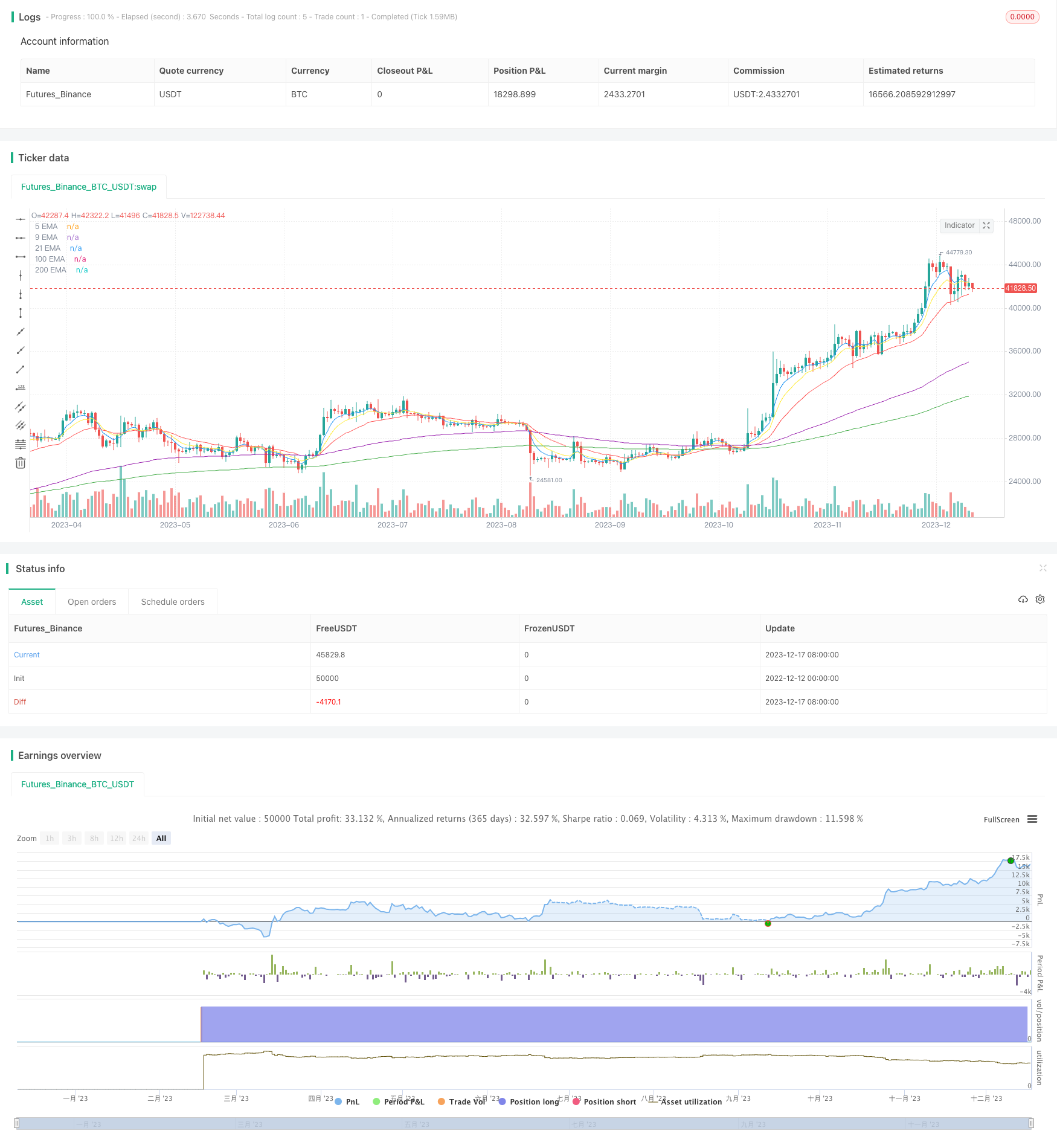
概述
均线交叉策略是一种使用不同周期的指数移动平均线(EMA)进行交易信号生成的量化交易策略。该策略运用 5 周期、9 周期和 21 周期三条 EMA 的交叉情况来判断市场趋势和产生买入和卖出信号。同时,该策略还结合较长周期的 100 周期和 200 周期 EMA 来判断大趋势。
策略原理
该策略的核心指标是 5 周期、9 周期和 21 周期三条 EMA。其交易逻辑基于以下几点:
5 周期 EMA 突破向上跨越 9 周期 EMA 时产生买入信号;5 周期 EMA 突破向下跨越 9 周期 EMA 时产生卖出信号。
21 周期 EMA 可用来验证交易信号。即 5 周期 EMA 和 9 周期 EMA 均高于 21 周期 EMA 时,买入信号更有效;两者均低于 21 周期 EMA 时,卖出信号更有效。
100 周期和 200 周期 EMA 用于判断市场中长期趋势。它们可为短期交易信号提供大趋势上的验证或警示。
优势分析
该策略具有以下几点优势:
操作简单,易于实施。EMA 的计算及交叉情况的判断非常简单。
对市场反应灵敏。5 周期和 9 周期 EMA 对价格变化十分敏感,能快速捕捉短期趋势。
容易设置止损止盈。EMA 本身可作为移动止损线。
可扩展性好。可轻松引入其他周期 EMA 或技术指标来丰富系统。
风险分析
该策略也存在以下主要风险:
虚假信号风险。EMA 交叉并非百分之百可靠,可能出现假突破。应结合其他因素仔细判断。
趋势反转风险。快速 EMA 交叉可能仅反映短期调整,忽略大趋势反转。应参考中长期 EMA。
Parameter Tuning 风险。不同品种和市场条件下参数设置会有很大差异,需要充分优化和测试。
优化方向
该策略可从以下几个角度进行优化:
引入其它指标过滤信号,如KD,MACD等,降低虚假信号概率。
加大止损幅度,降低单笔损失。或trailing stop随动止损锁定利润。
对参数进行优化,找到最优周期参数组合。还可使用机器学习方法动态优化。
结合量化框架,自动化整个交易流程。
总结
该均线交叉策略整体思路清晰,易操作性强,能有效捕捉短期趋势。但仅仅依赖EMA交叉作决策仍然存在一定盲区,需辅助其他因素来决策,降低风险。该策略优化空间较大,有望通过引入更多指标或技术手段来丰富策略内容,提高稳定盈利能力。
/*backtest
start: 2022-12-12 00:00:00
end: 2023-12-18 00:00:00
period: 1d
basePeriod: 1h
exchanges: [{"eid":"Futures_Binance","currency":"BTC_USDT"}]
*/
// This source code is subject to the terms of the Mozilla Public License 2.0 at https://mozilla.org/MPL/2.0/
// © nagversion
//@version=5
strategy("5/9/21 EMA Strategy with 200 and 100 EMA", overlay=true)
// Calculate EMAs
ema5 = ta.ema(close, 5)
ema9 = ta.ema(close, 9)
ema21 = ta.ema(close, 21)
ema100 = ta.ema(close, 100)
ema200 = ta.ema(close, 200)
// Plot EMAs
plot(ema5, title="5 EMA", color=color.blue)
plot(ema9, title="9 EMA", color=color.yellow)
plot(ema21, title="21 EMA", color=color.red)
plot(ema100, title="100 EMA", color=color.purple)
plot(ema200, title="200 EMA", color=color.green)
// Strategy conditions
longCondition = ta.crossover(ema5, ema9) and ta.crossover(ema9, ema21)
shortCondition = ta.crossunder(ema5, ema9) and ta.crossunder(ema9, ema21)
if (longCondition)
strategy.entry("Long", strategy.long)
if (shortCondition)
strategy.entry("Short", strategy.short)
// Set strategy properties if required (like stop loss, take profit, etc.)